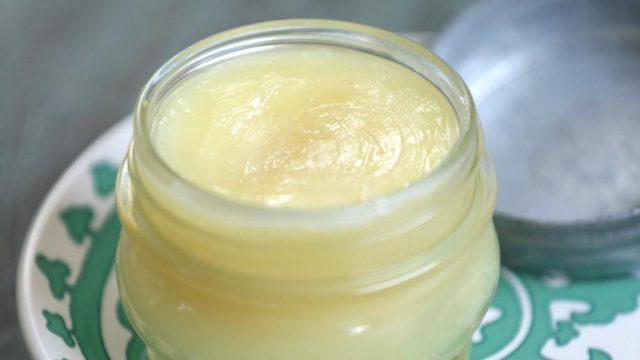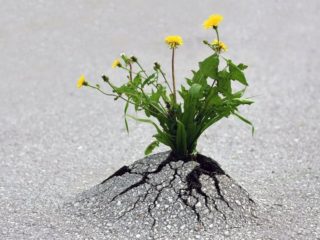Content
The use of coltsfoot is widely practiced in traditional medicine. Before using a medicinal herb, you need to study its features and composition.
Description of coltsfoot
Coltsfoot (Tussilago) is a perennial herbaceous plant of the Asteraceae family. It has a long branched creeping rhizome. In early spring, erect flowering shoots with ovate-lanceolate brownish leaves appear above the ground. Each one develops a single bright yellow head.
Some time after the buds open, vegetative stems are formed. They do not bear flowers, but are covered with round-heart-shaped leaves, pubescent below and bare above, on long petioles. Coltsfoot fruits are elongated achenes with soft tufts. Flowering shoots die soon after they ripen.

Coltsfoot is a honey plant; bees collect pollen and nectar from the crop.
When the coltsfoot blooms
Coltsfoot blooms very early, even before the leaves bloom on the trees. Usually the first yellow baskets appear in early or mid-April when warm weather sets in. Flowering lasts about 45 days.
Where does coltsfoot grow up in Russia?
The perennial plant is widespread throughout Russia. You can meet the culture in the Central regions of the country and in Siberia, in Central Asia and the Far East, in the Murmansk region and even in the Arctic regions.
The medicinal coltsfoot settles along roadsides, in fields, near human habitation, and on the banks of reservoirs. You can meet it in vacant lots, vegetable gardens and even landfills.
Chemical composition of coltsfoot
The properties of the medicinal plant coltsfoot are due to its rich chemical composition. The medicinal herb contains:
- vitamin C;
- glycosides and saponins;
- carotenoids;
- tannins;
- tartaric and malic acids;
- sitosterol and inulin;
- flavonoids;
- stigmasterol and taraxanthin;
- dextrans;
- mucus;
- essential oil;
- arnidol and faradiol.
The rich composition gives the medicinal plant strong anti-inflammatory, softening and healing qualities.
Healing properties of coltsfoot
Coltsfoot is used to treat many ailments. When used correctly, a plant-based product:
- promote expectoration when coughing and relieve sore throat;
- improve the condition of the digestive system;
- due to diaphoretic properties, they reduce the temperature during fever;
- promote healing of wounds and cuts;
- soothe muscle pain;
- normalize the functioning of the nervous system;
- regulate blood pressure and strengthen blood vessels;
- improve the condition of the skin and hair;
- relieve inflammation of the genitourinary system;
- strengthen general immunity;
- improve the condition of the bronchi and lungs.
Coltsfoot treats gynecological diseases in women, normalizes the menstrual cycle and balances hormonal levels. Using herbal-based products is useful for inflammation of the appendages.
It is recommended for men to take decoctions and infusions of the plant to prevent prostatitis and adenoma. When used externally, the medicinal herb protects against early baldness.
Indications for use of coltsfoot
The use of coltsfoot in folk medicine is recommended for many diseases. In particular, it is allowed to use decoctions and infusions:
- with cough and runny nose;
- for diseases of the stomach and intestines, loss of appetite;
- for kidney inflammation;
- with varicose veins;
- for chronic headaches;
- with scrofula and dropsy;
- for bronchitis and tuberculosis in the early stages;
- with inflammation of the middle ear;
- for bronchial asthma;
- at high temperature.
Externally, the medicinal herb is used to treat the skin for abscesses, boils, wounds and burns. The use of perennials is justified for psoriasis and dermatitis.
Application of leaves and flowers of coltsfoot
The benefits of coltsfoot flowers are fully revealed with proper processing of the medicinal plant. Traditional medicine advises preparing several vitamin preparations based on herbs.
Coltsfoot cough medicine for children
Coltsfoot for bronchitis and cold coughs in children promotes the removal of sputum and fights the infectious process.The following decoction of a medicinal plant has a good effect when used:
- The grass is crushed in a volume of 10 g.
- Mix with 3 g lard.
- Pour the ingredients into 500 ml of milk.
- Boil over low heat for ten minutes, covered.
- Cool and strain to remove sediment.
The child should take the drug 50 ml once a day before bedtime.

You can offer a decoction of coltsfoot to a child who coughs from the age of five
Tea
It is recommended to brew coltsfoot leaves as tea if you have a weakened immune system, a cold or vitamin deficiency. The drink recipe looks like this:
- The leaves and inflorescences of the plant are crushed in a volume of 5 g.
- Pour a glass of boiling water over the raw material.
- Leave covered for ten minutes.
The finished tea is poured into a cup through a strainer. You can use it with honey, but it is better not to use sugar.
Infusion
Taking coltsfoot in the form of an infusion is useful for respiratory diseases, cholecystitis and intestinal inflammation. The remedy is done as follows:
- The raw material is crushed in a volume of 20 g.
- Pour in 200 ml of hot water.
- Leave covered for half an hour.
- Strain through cheesecloth.
You need to take the drug 30 ml up to four times a day.
Decoction
A perennial decoction is recommended for use for problems with the kidneys and stomach, cough and bronchitis, and varicose veins. The remedy is prepared according to the following algorithm:
- Pour 20 g of dry leaves of the plant into an enamel pan.
- Pour a glass of fresh boiling water.
- Simmer in a water bath for about 15 minutes.
- Remove from heat and cool the broth.
- Strain from the sediment and squeeze out the raw materials.
- Top up with clean water to the initial volume.
You need to drink coltsfoot four times a day, 100 ml.
Fresh Juice
Perennial juice obtained from fresh leaves has strong medicinal properties. Extrude it as follows:
- Young plant plates are washed to remove dirt and dust.
- Scald the leaves with boiling water to disinfect and drain in a colander.
- After the liquid has drained, grind the vegetable mass through a meat grinder or grind it in a blender.
- The resulting pulp is wrapped in folded gauze and squeezed out properly.
Fresh juice is diluted with water in equal volumes and taken 15 ml. It is recommended to consume it on a full stomach three times a day. The product is recommended for use for various inflammations and bronchitis.

Drinking coltsfoot juice is useful during the period of quitting smoking to reduce cravings for cigarettes
Alcohol infusion
Coltsfoot is useful for humans in the form of a strong alcohol tincture. The medicinal drug is prepared according to the following recipe:
- Pour about 100 g of inflorescences and leaves of grass into a glass jar.
- Pour in 100 ml of high-quality vodka.
- Cover the container with a lid and put it in a dark place for two weeks.
- After the period has passed, filter the drug.
The use of tincture is beneficial for colds and sore throat. The product is diluted in a small amount of water, 30-40 drops each, and consumed on an empty stomach three times a day.
Other
The medicinal properties of coltsfoot flowers are revealed in some other recipes. Based on the plant, remedies are prepared to treat colds, as well as for external use.
Syrup
The remedy helps well with respiratory tract ailments. The syrup creation scheme looks like this:
- Fresh leaves and flowers of the perennial are washed, crushed and sprinkled with granulated sugar in a glass container.
- The vessel is put in a dark, cool place for a week.
- After the period has passed, the raw materials, together with the released juice, are transferred to another container.
- Add 200 ml of honey and mix thoroughly.
- Store in cool and dark conditions for another week.
The finished syrup is filtered from residual raw materials and poured into a glass bottle. The product must be stored in the refrigerator. The drug should be taken 15 ml half an hour before meals up to four times a day.
Powder
The use of perennials externally is usually carried out using plant powder. The remedy is made from dried leaves and flowers - the raw materials are crushed by hand or using a blender.
The finished powder is diluted with a small amount of water to a paste. The mass is applied to bruises, wounds and cuts, and is used for compresses for inflammatory skin diseases.

If you mix coltsfoot powder with Vaseline, you can get a homemade ointment for external use.
Contraindications and harm to coltsfoot
The benefits and harms of coltsfoot depend on the individual characteristics of the body. It is necessary to stop using the herb:
- for liver diseases;
- with exacerbation of pancreatitis;
- for individual allergies.
When using medications, safe dosages must be carefully observed. Otherwise, the herb can lead to the development of side effects - migraines, nausea and diarrhea, dizziness. The use of coltsfoot for treatment is practiced for no longer than four weeks in a row.
Is it possible to have coltsfoot during pregnancy?
The benefits of coltsfoot for women are not always clear.The medicinal plant has a beneficial effect on the immune system, protects against colds and helps to cope with cough faster.
However, during pregnancy it is better to avoid using the herb. It contains a large amount of alkaloids that are harmful to the developing fetus and can lead to miscarriage. When breastfeeding, coltsfoot should also be excluded from the diet - it negatively affects the composition of milk.
Use in children
When used carefully, medicinal coltsfoot can bring benefits to a child’s body. It is recommended to brew the plant for coughs and runny noses in children, for inflammation of the tonsils, for ear diseases and diathesis.
At the same time, it is allowed to offer decoctions and infusions of the plant to a child for the first time only after five years. Dosages must be kept to a minimum. If side effects occur, use of the medicinal herb should be discontinued immediately.

Coltsfoot can cause rashes, itchy skin and diarrhea in children
Preparation and storage
All parts of coltsfoot are suitable for medicinal use - leaves, inflorescences, stems and roots. The procurement time depends on what kind of raw material we are talking about.
The flowers and leaves of the medicinal plant are usually collected in May, at the peak of their decorative value. The green parts are carefully cut off with a sharp tool and dried in the fresh air under a canopy. The plates for the workpiece are chosen to be bright green, without stains or any damage. It is desirable that by the time of collection the leaves have already lost their whitish pubescence. Coltsfoot greens can be washed before drying; flowers are not subjected to this procedure.
The roots of the plant are harvested for medicinal purposes in mid-autumn. After collection, the raw materials are washed from soil residues and cut into small pieces, and then dried in a warm room or in an oven at a temperature of no more than 50 ° C.
The coltsfoot should be stored in a paper bag or fabric bag in a dark place with low humidity. The roots retain valuable properties for up to a year, inflorescences and leaves - for 2-3 years.
It is necessary to collect the plant for medicinal purposes only in clean areas away from roads, landfills and industrial enterprises. It is recommended to carry out the preparation on a dry but cloudy day.
Conclusion
The use of coltsfoot is beneficial for many diseases. The plant has strong medicinal properties, but in some cases it can cause harm to the body.








